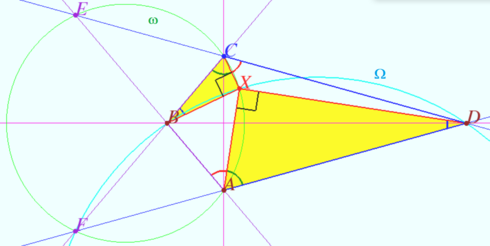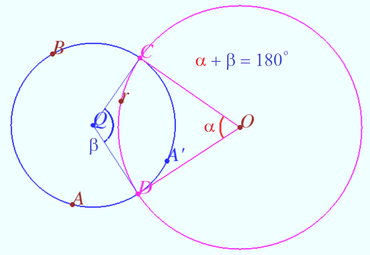Difference between revisions of "2018 IMO Problems/Problem 6"
(→Solution) |
(→Solution) |
||
| Line 27: | Line 27: | ||
Similarly, <math>\angle AXD = 90^\circ \implies \angle BXA + \angle DXC = 180^\circ.</math> | Similarly, <math>\angle AXD = 90^\circ \implies \angle BXA + \angle DXC = 180^\circ.</math> | ||
| − | <i><b>Claim 1</b></i> Let A, C, and E be arbitrary points on a circle | + | <i><b>Claim 1</b></i> Let <math>A, C,</math> and <math>E</math> be arbitrary points on a circle <math>\omega, l</math> be the middle perpendicular to the segment <math>AC.</math> Then the straight lines <math>AE</math> and <math>CE</math> intersect <math>l</math> at the points <math>B</math> and <math>D,</math> symmetric with respect to <math>\omega.</math> |
| − | <i><b>Claim 2</b></i> Let points B and D be symmetric with respect to the circle | + | <i><b>Claim 2</b></i> Let points <math>B</math> and <math>D</math> be symmetric with respect to the circle <math>\omega.</math> Then any circle <math>\Omega</math> passing through these points is orthogonal to <math>\omega.</math> |
<i><b>Claim 3</b></i> The sum of the arcs between the points of intersection of two perpendicular circles is <math>180^\circ.</math> | <i><b>Claim 3</b></i> The sum of the arcs between the points of intersection of two perpendicular circles is <math>180^\circ.</math> | ||
| − | In the figure they are a blue and red arcs CD, | + | In the figure they are a blue and red arcs <math>\overset{\Large\frown} {CD}, \alpha + \beta = 180^\circ.</math> |
Revision as of 13:41, 17 August 2022
A convex quadrilateral ![]() satisfies
satisfies ![]() Point
Point ![]() lies inside
lies inside
![]() so that
so that
![]() and
and ![]() Prove that
Prove that ![]()
Solution
Special case
We construct point ![]() and prove that
and prove that ![]() coincides with the point
coincides with the point ![]()
Let ![]() and
and ![]()
Let ![]() and
and ![]() be the intersection points of
be the intersection points of ![]() and
and ![]() and
and ![]() and
and ![]() respectively.
respectively.
The points ![]() and
and ![]() are symmetric with respect to the circle
are symmetric with respect to the circle ![]() (Claim 1).
The circle
(Claim 1).
The circle ![]() is orthogonal to the circle
is orthogonal to the circle ![]() (Claim 2).
Let
(Claim 2).
Let ![]() be the point of intersection of the circles
be the point of intersection of the circles ![]() and
and ![]()
![]() (quadrilateral
(quadrilateral ![]() is cyclic) and
is cyclic) and ![]() (quadrangle
(quadrangle ![]() is cyclic). This means that
is cyclic). This means that ![]() coincides with the point
coincides with the point ![]() indicated in the condition.
indicated in the condition.
![]() subtend the arc
subtend the arc ![]() of
of ![]() subtend the arc
subtend the arc ![]() of
of ![]() The sum of these arcs is
The sum of these arcs is ![]() (Claim 3)..
(Claim 3)..
Hence, the sum of the arcs ![]() is
is ![]()
the sum ![]()
Similarly, ![]()
Claim 1 Let ![]() and
and ![]() be arbitrary points on a circle
be arbitrary points on a circle ![]() be the middle perpendicular to the segment
be the middle perpendicular to the segment ![]() Then the straight lines
Then the straight lines ![]() and
and ![]() intersect
intersect ![]() at the points
at the points ![]() and
and ![]() symmetric with respect to
symmetric with respect to ![]()
Claim 2 Let points ![]() and
and ![]() be symmetric with respect to the circle
be symmetric with respect to the circle ![]() Then any circle
Then any circle ![]() passing through these points is orthogonal to
passing through these points is orthogonal to ![]()
Claim 3 The sum of the arcs between the points of intersection of two perpendicular circles is ![]() In the figure they are a blue and red arcs
In the figure they are a blue and red arcs ![]()











